Review: Dungeon Siege 3
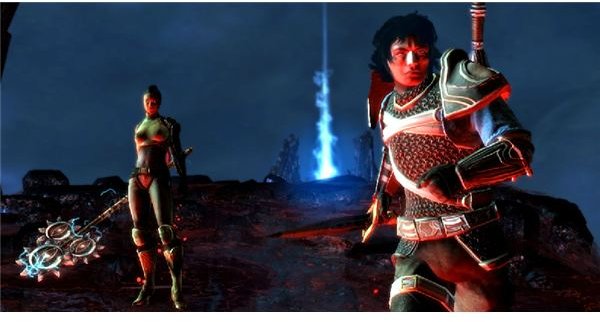
Gameplay (4 out of 5)
If you’ve ever played a Dungeon Siege game before, you have an idea of what to expect. Hack and slash through exotic locales and piles of monsters in order to obtain better, shinier loot. Beyond that though, Dungeon Siege 3 brings a lot of new inspiration to the mix, a reflection of the fact that a new studio, Obsidian, has taken control of its development. This is a story driven Dungeon Siege with a full Mass Effect style conversation system and four player characters that have unique backstories that tie them into the world.
These characters aren’t customizable down to the color of their mustache, like in the Dungeon Sieges of old, but rather fill archetypes with their appearance and powers, an approach more like that of Baldur’s Gate: Dark Alliance. There’s a nobleman’s son with a sword, a gun slinging witch’s daughter, a tinkering mage with a white beard and an archon with hair made of flames.
You make your chosen character your own by equipping them with various magical loot you’ll find laying about, and by choosing which abilities to give them. How often you use those abilities comes into play too. You’ll occasionally see your favorites upgrading just from sheer use, something a little more organic than the ability and skill point distribution you’ll do at level up.
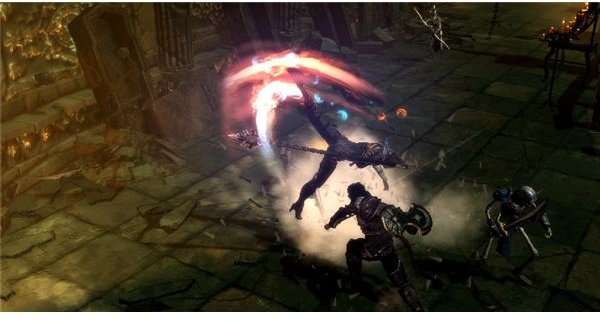
The abilities are fun, if somewhat limited, and each character is really no more powerful than any other. The abilities are different to be sure, but there is usually a rough equivalent in the other characters to keep everything balanced. For example, the fire spirit can summon a flaming jackal while the mage can summon a spectral copy of himself. Every character can heal themselves, they all have long and short-range attacks, and each has abilities that focus on hitting multiple versus individual targets. Choose the character you like the look of and don’t be worried about whether you can summon walls of fire or not, they’re all equally viable choices.
The minute to minute is fun and fast paced. There’s always a few side quests in between main story missions to give you a little break, though tackling these often means doing some backtracking through terrain you’ve already explored. Luckily, like the old Dungeon Sieges, the game is more or less seamless, and wandering back into the woods to save Olga’s boyfriend won’t involve six different load screens.
Perhaps my only big gripe is that many of the stats attributed to items and skills are so cryptic that there’s no telling what they do. What exactly does it mean if my gloves give me a +10 to chaos? While this knowledge doesn’t seem to keep me from playing the game well, it is sort of disappointing in an RPG, where stats make up so much of who you are and how you play.
User Interface / Controls (3 out of 5)
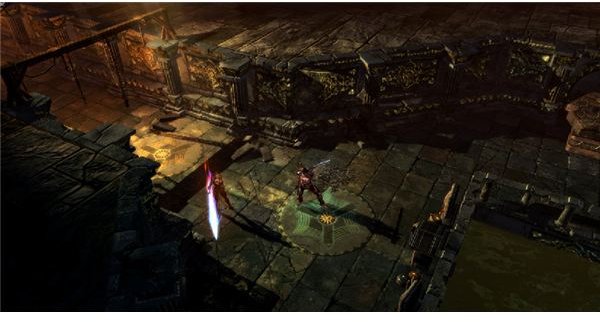
Unlike the first two Dungeon Siege games, which were PC exclusives, Dungeon Siege 3 made the foray onto the Xbox 360 and Playstation 3, and by all accounts prefers the consoles in its delivery. Play this game for five minutes and you’ll understand why. Playing on the hardest difficulty, I spent about fifty percent of every battle using a hit and run strategy with my teleporting and ranged abilities where a fraction of a second means the difference between a hundred and twenty damage or a boost to my mana. This kind of fast paced twitch gaming seems almost unfathomable on a keyboard, and takes me back to all my thousand deaths in a PC version of Tomb Raider. There’s something about action and agility based gameplay that lends itself to a controller, and while the previous games in the series may have been more click and strategy based, this version of Dungeon Siege definitely feels like it needs a joystick.
The catering to consoles does not end at the fast paced controls. Indeed the entire character progression system seems made for consoles. For example, there are only so many abilities as can be easily mapped to your face buttons. Three are displayed at any given time, with a trigger displaying three more, and the left bumper switching to another set.
The interface is perhaps the only thing that doesn’t feel quite right on consoles. Your start menu and the screen that displays your quest log, inventory and abilities are completely separate. For some reason, the D-pad is also mapped to the aforementioned sub screens, and often when you’re trying to hit up to get your fable-style breadcrumb trail, you’ll accidentally mash one of the other buttons and end up on your stats screen instead.
The HUD works fine, but once you get the swing of whatever character you’ve chosen, you’ll hardly be using it. The minimap is essentially useless considering the radioactive breadcrumbs will lead you wherever you need to go, and journeys off the beaten path don’t go far enough to leave sight of the road. All you’ll really need is to occasionally look at your ability mapping, especially when switching between stances, but since there’s no opportunity to ever change the mapping of your abilities, this will probably become second nature.
Multiplayer (3 out of 5)
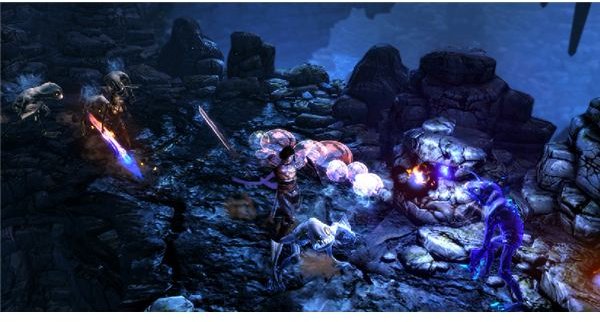
I put the majority of my time playing this game into local co-op, and I found it mostly very well implemented. You share inventory, so there’s no fighting over who gets to pick up those pants of chaos, and there’s a lot of fun ways to customize your abilities that help your partner. The camera works well most of the time, drawing farther out to accommodate both players until you get too far apart, whereupon it zaps one to the side of the other. The biggest problem I noticed with this was when the other player died, the camera remained tied to them. So even if you had no intention of helping them up for the time being, because your butt was being chewed on by six minotaurs, you couldn’t run any farther from them than you normally would. This was especially aggravating in large boss fight areas, which are typically closed off and inescapable anyway.
Luckily, if you tire of having your friends hold you back from your true gaming potential, you can always ask them to leave and have an AI take their place. Their character will be waiting for them when they learn how to play better. Unfortunately the same isn’t always true for online multiplayer, where transferring your character from another file is impossible, and character selection comes down to whatever hasn’t been chosen yet.
Graphics (4 out of 5)
Overall, the graphics are great, especially when compared with similar recent games on the console like Sacred 2 or D&D: Daggerdale. In terms of environments, the graphics are absolutely lovely. There’s a variety of memorable dungeon locales to visit, each filled with their own kind of loot repository, like barrels, vases, sarcophagi or slug eggs. The lighting is dramatic and helpful in guiding you through the best parts of the level should you choose to forsake the bread crumbs. This is not a bad idea since the most breakable stuff is usually off the main path. The effects for spells and abilities are very, very satisfyingly cool. Whether you’re disappearing into a cloud of blue smoke or summoning a column of fire, there’s a lot of wow factor in the visuals. Animations are similarly satisfying, with a lot of fun head kicking and spear chucking
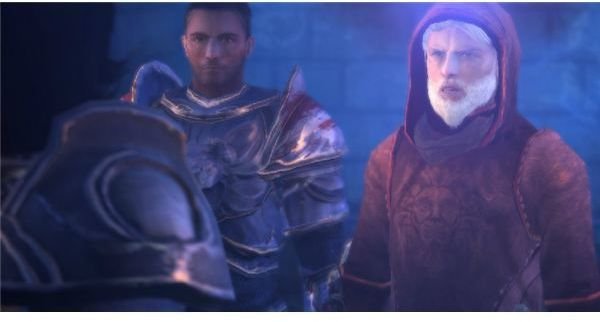
going on.
The characters unfortunately don’t quite live up to the environments. A lot of the NPCs have a sort of plastic, universally young look about them, and while their cleavage is ample, the delivery of their lines is often very flat.
The player characters look good in the dialogue and cutscenes, but during the majority of the game you may be wondering if they’re ever going to change their pants. The game does feature several different looks for each character, but before you find them you’ll have to go through about five hundred white shirts that are indistinguishable save for their stats and names like “fierce shirt of rage.”
Sound (3 out of 5)
With a game like this, there’s sort of an expectation for the sound, and as long as it doesn’t stray too far everything should be fine. Epic battle music is standard, and you expect a certain quality of bone crunching and inappropriate moaning noises when your character gets hurt. As my sound design professor in college said, “The best sound is what you don’t notice.” What he meant by that is that it’s supposed to serve to augment your experience. It’s not supposed to be noticeable in a way that distracts you.
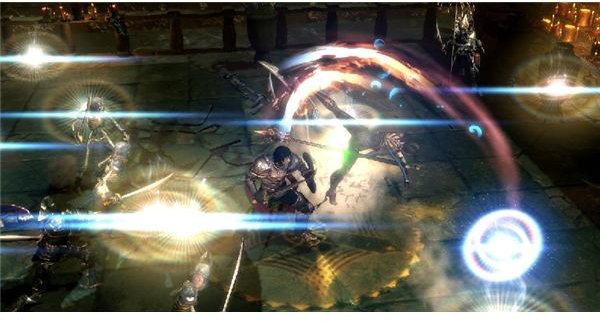
Now most of the time I’d say this game does just fine at that. Footsteps sound correct on different surfaces, bones clatter on the ground when you kill a skeleton, magical abilities have suitable signature sounds, and the voice acting is passable, but every so often something weird will pop up that actually takes you out of the game for a moment.
For example, at one point I was over at a friend’s house trying out the local co-op with him. We were in a haunted house slicing through droves of ghosts and animated skeletons. We’re in the middle of a fight and we think we hear his cat meowing at the back door. We get up and look and the cat’s taking a nap. We repeat this process about three times before we figure out somebody decided to loop elderly kitty sounds in the middle of our battles with the hordes of the undead.
Overall / Final Score (3 out of 5)
I personally appreciated the many changes to the series, though old school fans may not. The hack and slash is still present, but with story and finesse I didn’t see in the previous games. Full price seems a little much when there are so many good older alternatives out there that provide nearly the same gameplay, but the polish of this title is hard to deny, and combined with the soft spot I have in my heart for Obsidian, I have to recommend this game, especially for those looking for some well crafted couch co-op. If you didn’t like the series before, don’t hold it against this one, it’s a very different game.
References
All images taken from the official Dungeon Siege 3 site, https://www.dungeonsiege.com/
All references from writer’s own experience with Dungeon Siege 3, Xbox 360 version.
